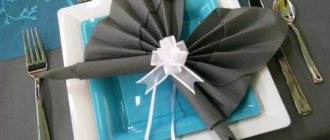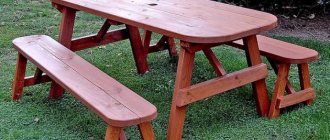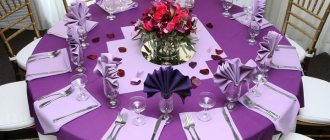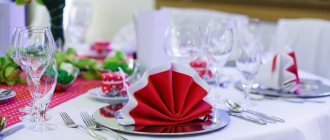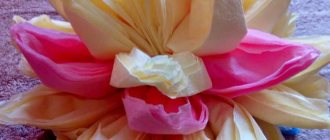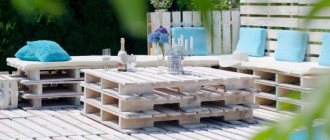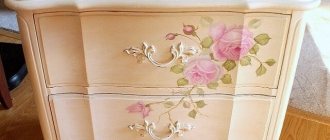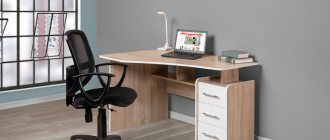Useful tips
Watch the video if you are too lazy to read
Watch the video if you are too lazy to read
As a rule, the festive table is decorated with interesting dishes, beautiful glasses and cutlery, but all this is perfectly complemented by original folded napkins for guests.
Paper napkins can be folded in many different ways to make your table more elegant and make a great impression on everyone.
Here are the most interesting ways to fold paper napkins for any table and for any event:
How to quickly fold paper napkins
1. Place the folded napkin on the table so that the corner where all the folds meet is on top (see image).
2. Start folding the bottom ends of the napkin upward, but leave a little space at the top after each folded end.
3. When you have folded all the ends of the napkin, turn it over.
4. Turn the napkin with the large end down so that it is shaped like the Superman sign.
5. Fold the left and right sides into thirds, one on top of the other.
6. Turn the napkin over.
*If you wish, you can put a beautiful stamp on the tip of the napkin.
Rules of good manners
The use of napkins is subject to good manners. In principle, compliance with them will not be difficult.
This is how they wipe the utensils with napkins; if in a catering environment this is acceptable, then at a party such a gesture can be considered an insult to the hostess of the house, expressing doubt about the cleanliness of the equipment.
It is unacceptable to use a napkin to wipe your face. It is needed to wet your lips and nothing more.
At the end of lunch, the napkin is placed on the right, next to the cutlery. If you want to throw away the used napkin, you will have to bother the hostess of the feast with this issue.
Beautiful paper napkins on the table: double fan
1. Place the napkin laid out on the table.
2. Fold in half (from bottom to top).
3. Bend the top layer down (towards the bottom edge).
4. Turn the napkin over.
5. Fold the top layer down (toward the bottom edge).
6. Fold the napkin evenly like an accordion.
7. Take the napkin in your hand so that there are 2 layers on top. Fold the first layer inside each inner accordion piece downwards (see image).
8. Gently spread the napkin to form a fan.
Video instruction using a cotton napkin as an example:
Volumetric figures Candle and Crown
Flat shapes are easy to make. But there are also three-dimensional figures - a candle and a crown - that can be made in a couple of minutes. The candle is well suited for a romantic dinner or New Year's party, and the crown will act as a stand for spruce branches or flowers. For the crown, it is better to take a napkin with openwork edges. Such a craft will look solemn.
- Candle. Fold the napkin into a triangle, moving the edges one centimeter inward. For a stable base: five centimeters of the lower part of the triangle is rolled up into a tube. Turn the napkin over, holding the fold with your fingers. They begin to roll the tube from any angle. The free end of the fabric is fixed in the previous fold. The candle is placed on a saucer and the wick is decorated. To do this, the outer edge of the fabric is folded outward and the inner edge is twisted.
- Crown. The napkin is folded into a triangle, from which a diamond is formed. The rhombus is turned over with its back side up and the lower part is folded over to form a triangle. The corners of the triangle are bent back, tucking one into the other. The crown is straightened and placed on a beautiful stand.
On a note!
To secure the edges of the shape and make it easier to complete, you can use a paper clip. But it is necessary to remember that paper products are easy to tear. Therefore, you should work carefully.
Napkins decorated in this way decorate the table and give it an aesthetic appearance. They are easy to make, so you can involve children in the making process. They will be happy to master the skill of creating three-dimensional figures from napkins. This is an exciting activity, the result of which will delight the hosts of the holiday and guests.
Festive paper napkins: aster in a plate
Below is a video instruction for a more detailed analysis.
1. Lay out the napkin and place it on the table.
2. Fold the bottom and top to the middle.
3. Turn the napkin so that it lies across the table. Fold the top and bottom towards the middle.
Press the folds down well to maintain shape.
4. Unfold the napkin to a rectangular shape (with two opposing folds made in step 2). You will get 4 folds that divide the napkin into 4 rectangles (2 on each side).
5. Now you need to make 8 out of 4 rectangles (each of them will become an aster petal in the future). Start folding the napkin evenly like an accordion. First, turn the napkin over and start with the fold towards you and then away from you.
6. Prepare aster petals. From all the folds you need to make three-dimensional triangles. The work will be done with a quarter of the folds.
Start tucking the edges of the folds inside, after which you need to bend them so as to get triangles - the petals of a paper flower.
7. When all the edges of the folds are folded into triangles, connect the outer triangles to each other and the flower is ready. Place it on a plate.
Video instruction
Color addition schemes
Flowers, whether they are fresh or gracefully folded from napkins, will enliven any table, and can even become a symbol of the holiday. The lotus, for example, is associated with vitality and perfection, the white lily with purity and innocence, and the rose with love and passion.
Lotus
The lotus, being a symbol of purity and purity, will look harmonious on the wedding table:
- To create this beautiful flower, you need to completely unfold the napkin and bend all the corners into the center to create an equilateral diamond shape.
- Turn face down and repeat the procedure until you get a square.
- Now you need to carefully remove the lower “petals” from each corner and place them on a plate.
Tulip
Folding paper napkins beautifully in the shape of a tulip is also not difficult:
- First, you need to bend the fully straightened workpiece diagonally until you get a triangle facing right angles downwards, which should be turned up until it touches the edge of the figure.
- Now fold the right and left corners towards each other, slightly overlapping each other.
- Bend the lower ends upward until you get a straight line at the bottom.
- All that remains is to give it the shape of a tulip, bending the side corners under the workpiece and securing them at the back.
The flower can be laid flat or, giving it a rounded appearance, placed vertically on a plate.
Rose
The Queen of Flowers will decorate any holiday with her beauty and aroma. But even rolled up from a paper napkin, it will pleasantly enliven the feast.
Step-by-step production:
- First you need to create a triangle from a napkin, which is twisted into a tight tube, leaving a small free end for future “leaves”.
- Now you need to roll the workpiece into a “roll” and carefully secure the edge.
- Pull the remaining ends, straightening them as a base, and turn the resulting flower over.
This rose looks wonderful in a glass or bowl, but just next to the cutlery it will be nice to highlight the beauty of the serving.
Lily
Origami in the form of this simple flower looks harmonious on a table dedicated to any special event:
- Again the process begins with a triangular blank placed at a right angle upwards.
- Next, you need to raise the side ends to the top until you get a rhombus with slightly open corners.
- Fold the bottom corner up 1 cm not reaching the edge of the workpiece, then bend part of it to the bottom line.
- Now bend the side ends of the figure under it, securing it on the back side in the form of a pocket.
- Return the lily to its original position, giving it a rounded shape and removing 2 side petals.
There are a number of rules for using napkins at the table.
After studying the schemes for folding paper napkins into beautiful images, it is worth mentioning the basic rules of etiquette for their use:
- If the napkins are located individually on the table, then they must be used. Fabric ones can be placed on your knees to protect clothes from accidental food, paper ones can be used to blot your mouth after eating, or you can gently wipe your fingers.
- The napkins should be unrolled after the host does this and the first course is served.
- When leaving the table, the napkin is left to the left of the plate. The same is done after finishing the meal.
It is not recommended to actively shake the napkin, trying to unwrap it, wipe your face with it instead of a towel, and leave it on the plate after finishing dinner or lunch.
Inviting friends and family, decorating a festive table beautifully, folding napkins, both fabric and paper, with imagination, preparing gourmet or simply everyone’s favorite dishes is not a difficult, exciting process and a wonderful break from the constant stress of city life.
Peacock formation
Fabric napkins often have patterns. It’s hard not to use the appropriate frame when you need to create a peacock.
After all, the royal bird is literally full of colors. True, the peacock will have to be formed from two napkins. Moreover, they can be either the same or different.
In the latter case, one workpiece should be light, the other dark. The formation itself occurs sequentially:
- First, a long napkin is folded into a fan and immersed in a long glass or glass;
- Next, the second medium or long napkin is folded into a flying kite, after which its sharp tip is bent.
The resulting hook looks like a long neck with a small head. This hook only needs to be immersed next to the fan so that the peacock takes on its characteristic shape. To save your budget, a beautifully folded paper napkin comes to the rescue.
But in this case, instead of folding the workpiece into a flying kite, it is better to use rolling it into a tube. One edge of this tube should be sharp, the other wide.
Forming a rose
Another amazing trick is beautifully folded napkins in a glass. In particular, we are talking about roses. While an aster takes a long time to shape, a rose requires much less manual dexterity:
- A red or pink napkin is folded into a triangle;
- The triangle is rolled into a tube;
- The tip of the tube bends inside the inflorescence.
But before immersing the rose in a glass, you will have to lay a peduncle at the bottom of the glass. To make it, just roll three or four small olive or green napkins into funnels.
After this, the funnels are smoothed with the palms and placed sequentially on the bottom of the glass. The peduncle passes the baton to the rose.
Formation of a cup holder-candy holder
Not only funny figures are formed from a napkin, but also practical shapes. A prime example of this is the stand. To figure out how to beautifully fold a napkin, the diagram is described point by point:
- The towel unfolds into a diamond shape;
- Each tip of the diamond must be folded into the center to form an envelope;
- The previous paragraph is repeated two more times (each time the envelope decreases);
- The envelope is turned over so that the corners can be folded back into the center to form an envelope;
- A glass is placed upside down on the tabletop and an envelope is placed on the bottom;
- The corners of the envelope are alternately turned outward.
The result is a blooming flower, on which it is convenient and interesting to place glasses and glasses. You can also put sweets in such a homemade container.
Note!
Kinusaiga technique - TOP-140 photos of the best ways to create crafts using the Kinusaiga technique with your own hands + instructions for beginners
Do-it-yourself passe-partout - a master class with step-by-step do-it-yourself schemes. Making tips + photos of the best examples
Decoupage with napkins: TOP-150 photos of ways to decorate with napkins. Simple instructions for beginners at home
Forming an Accessory Envelope
A festive table is not complete without a knife and fork. And if this pair is originally composed, then it will not leave its user indifferent. The thematic idea is again contributed by the cloth napkin:
- The product folds in four;
- The upper right corner is rolled into a tube until the latter touches the lower right corner;
- The previous step must be repeated two more times with each subsequent upper right corner, opened by rolling each previous layer into a tube;
- The product is turned over and bent in half so that only the part with the tubes is visible on one side;
The output is an envelope with sections into which you can insert a knife and fork.
We choose quality material
The fabric for napkins must be wear-resistant, light, airy, but at the same time have a high density. It should withstand several washes without losing its original appearance. Only three types of material meet these requirements.
Knowing how to fold fabric napkins beautifully, you can attract the attention of guests with an unusual table decoration.
- Cotton is the best option for everyday use. The material is not easily soiled, has increased density, and has a long service life. After several washes, the color and shape remain unchanged. The price is reasonable.
- Linen - even after ten washes, the shape retains its original appearance. The fabric is attractive, natural, and has absorbent properties. It is possible to starch and fold the material into any figure.
- Mixed fabrics are an adequate and reliable option. The composition includes natural and synthetic raw materials. The proportion of components may vary. Thanks to the combination, it has all the advantages of both types of raw materials. Does not shrink after washing and is wear-resistant.
Before guests arrive, you should take the time to decorate the table in an original way.
Device substrates
One of the popular innovations in festive and everyday table settings is large mats for plates, which have replaced the traditional tablecloth. There are special names: set, placement, blotter. They cope equally well with the aesthetic and functional side of serving, making cleaning easier, especially if there are children in the house, protecting the table surface and creating an elegant atmosphere. You can find round serving napkins (standard diameter 27 cm), square, rectangular and unusual shapes, such as heart-shaped ones.
Textile backings for plates
Important: the serving napkin should extend beyond the edges of the dish by at least 2.5 cm.
Modern interiors in the style of minimalism, hi-tech or loft do not imply an abundance of textiles; tablecloths look out of place in them. Substrates made of eco-leather, glass, dense plain textiles, wood, cork, bamboo, plastic and other original materials will fit into such an interior much better. You can get several sets for daily use and special occasions.
Important: glass countertops can be cold to the touch and require high maintenance. Placement backings will protect them from scratches and stains and create a more comfortable dining experience.
Substrate options by material:
- glass and porcelain coasters. Usually used for classic holiday serving and are part of the service;
— blotters made of eco-leather. They create the impression of discreet luxury, do not slip and perfectly protect the tabletop from scratches and temperature changes. Will be appropriate in both classic and loft interiors;
- substrates made of bamboo or cork. Budget and affordable option. Goes well with the decor in the oriental spirit and eco-style;
- plastic placements. The most durable and easy to maintain option. Great for small children. Will fit organically into a modern interior. For classic, Scandinavian, ethnic and country styles, you should choose more carefully and use vinyl rugs that look like textiles.
Placement for wickerware
Select the substrates so that they match the flower vase or candlesticks on the table, using the “rule of three”, like professional decorators, and then the dining table will become the point of attraction for the entire interior.
Forming a Romantic Heart
Well, a romantic heart suits Valentine's Day. They also often decorate wedding tables. Another reason to make themed decor is March 8th.
The main thing is that a romantic heart is assembled very simply:
- The napkin is folded in half, then doubled again;
- Both upper ends of the canvas are folded diagonally downwards so that they eventually adjoin each other and form a pentagon with a seam line in the middle;
- The two outer and inner corners are folded in to create two bulges.
Although the bulges will have angles, this will not affect the shape of the heart at all. It will turn out to be quite original - with a sharp bottom and two rounded sides on top. When using a red or pink napkin, the corresponding effect is enhanced significantly.
We are looking for the right size and shape
The usual parameters for serving a tabletop are 40x40 centimeters. The product has a square shape. Although for some, rectangular pieces are preferable. The choice depends on the method by which the fabric textiles will be folded.
For effective decoration, you should use not simple, but at the same time unusual options that do not require much time.
![How to beautifully fold napkins for a festive table: a variety of options [master classes]](https://1000koek.ru/wp-content/uploads/kak-krasivo-slozhit-salfetki-dlya-prazdnichnogo-stola-raznoobrazie-variantov-master4-330x140.jpg)
![How to beautifully fold napkins for a festive table: a variety of options [master classes]](https://1000koek.ru/wp-content/uploads/kak-krasivo-slozhit-salfetki-dlya-prazdnichnogo-stola-raznoobrazie-variantov-master-330x140.jpg)
